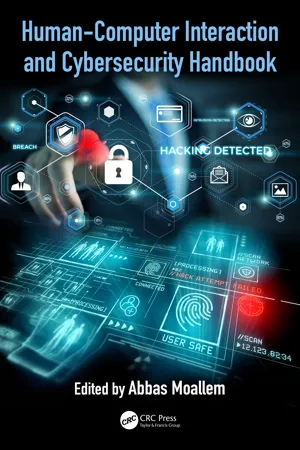
- 422 pages
- English
- ePUB (mobile friendly)
- Available on iOS & Android
Human-Computer Interaction and Cybersecurity Handbook
About this book
Recipient of the SJSU San Jose State University Annual Author & Artist Awards 2019
Recipient of the SJSU San Jose State University Annual Author & Artist Awards 2018
Cybersecurity, or information technology security, focuses on protecting computers and data from criminal behavior. The understanding of human performance, capability, and behavior is one of the main areas that experts in cybersecurity focus on, both from a human–computer interaction point of view, and that of human factors. This handbook is a unique source of information from the human factors perspective that covers all topics related to the discipline. It includes new areas such as smart networking and devices, and will be a source of information for IT specialists, as well as other disciplines such as psychology, behavioral science, software engineering, and security management.
Features
- Covers all areas of human–computer interaction and human factors in cybersecurity
- Includes information for IT specialists, who often desire more knowledge about the human side of cybersecurity
- Provides a reference for other disciplines such as psychology, behavioral science, software engineering, and security management
- Offers a source of information for cybersecurity practitioners in government agencies and private enterprises
- Presents new areas such as smart networking and devices
Frequently asked questions
- Essential is ideal for learners and professionals who enjoy exploring a wide range of subjects. Access the Essential Library with 800,000+ trusted titles and best-sellers across business, personal growth, and the humanities. Includes unlimited reading time and Standard Read Aloud voice.
- Complete: Perfect for advanced learners and researchers needing full, unrestricted access. Unlock 1.4M+ books across hundreds of subjects, including academic and specialized titles. The Complete Plan also includes advanced features like Premium Read Aloud and Research Assistant.
Please note we cannot support devices running on iOS 13 and Android 7 or earlier. Learn more about using the app.
Information
fourSmart networks and devices
nineSmart home network and devices
9.1Introduction
9.1.1Passwords
9.1.2Beyond passwords
9.1.3Network usability problems
9.1.3.1No professional administrators
Table of contents
- Cover
- Half Title Page
- Series Page
- Title Page
- Copyright Page
- Dedication
- Contents
- List of figures
- List of tables
- Preface
- Acknowledgments
- Introduction
- Editor
- Contributors
- Section I Authentication and access management
- Section II Trust and privacy
- Section III Threats
- Section IV Smart networks and devices
- Section V Governance
- Section VI Perspective
- Glossary
- Index